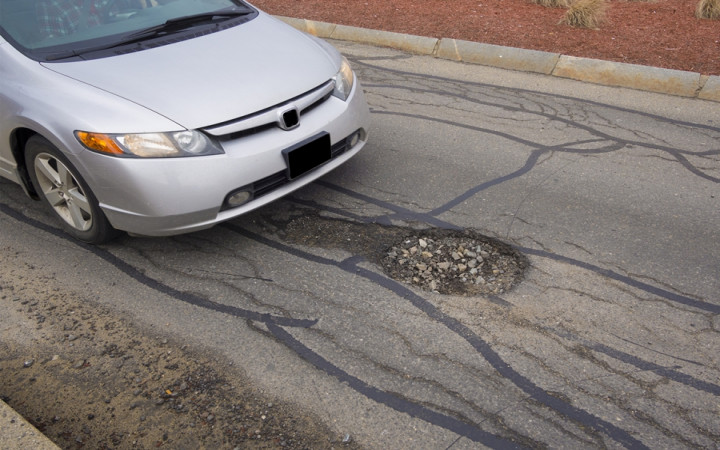Today’s Wonder of the Day was inspired by Jaiden. Jaiden Wonders, “How are potholes formed on paved roads?” Thanks for WONDERing with us, Jaiden!
Do you like to go for rides in the car? Maybe your family piles in and heads to Grandma’s house or to a soccer game. Family time in the car can be a fun way to get from Point A to Point B.
If you get to ride on smooth interstates, you probably enjoy the comfortable ride of today’s modern vehicles. From time to time, though, you may have to travel on smaller roads and streets. Occasionally, you’ll run into or over—usually with a big “whoomph!”—a hole in the road. It can jar your entire body, making you feel the bump to the depths of your bones.
What are we talking about? Today’s Wonder of the Day takes an up-close look at those roadway obstacles we call “potholes.” Depending upon where you live, you may have heard them called something else. You might say they’re “kettles” or, in the Western United States, even “chuckholes.”
Potholes are areas of road surface that have cracked, worn away, and eventually formed a hole. They start out as tiny cracks. If they’re not fixed right away, they can grow. Potholes may be anywhere from a few inches wide and deep to a few feet wide and several inches deep.
When vehicles travel on highways and city streets, they rely on a flat, smooth surface. This helps them move quickly, comfortably, and safely. Potholes make a ride bumpy and potentially dangerous. They can damage vehicle tires and even affect the alignment of a vehicle’s wheels.
Potholes develop naturally as a result of many scientific forces at work. It’s fun to drive on a newly paved road. But all that traffic takes its toll over time. Just think about what a beating the average roadway takes as millions of tires move across it at a high speed.
The friction of the tires with the roadway surface heats up the road and causes it to expand. Over time, this expansion can lead to the formation of cracks in the roadway surface. Water can then seep into these cracks.
Particularly in cooler weather, the freeze and thaw cycle can turn those tiny cracks into potholes in a hurry. When water from rain or snow seeps deep into roadway cracks, it can freeze when temperatures plummet at night. As water freezes, it expands, pushing against the edges of cracks. If it has seeped underneath the top layer of pavement, it can push up against the pavement from below.
When the temperature rises again, the water melts, leaving larger cracks—often called divots—throughout the roadway surface. Divots that form underneath the top layer of pavement can become potholes quickly. When vehicles drive over pavement with a divot below it, the weight can push the top layer of pavement into the space created by the divot. This leaves a hole in the roadway surface: a pothole!
Potholes occur in all roads, though. Just because you live in an area where it’s always warm doesn’t mean you’ll avoid potholes. Water has a way of eating away at road surfaces in any climate. Even without a freeze and thaw cycle, water can still get underneath pavement and create divots by eroding the materials, such as loose gravel, that form the roadbed.
Fortunately, road maintenance crews can fix potholes easily. Fixing a pothole requires a crew to clean all the loose rock and dirt out of the pothole before filling it with a mixture of hot or cold asphalt (depending upon the time of year) to create a patch in the roadway surface. Sometimes special chemicals are also used that act like a glue to make the asphalt patch stick to the surrounding pavement. You can think of this method as similar to the way a dentist fills a cavity in your teeth!
Have you ever been in a car or bus that hit a pothole? If so, you know just how annoying they can be! Most drivers will avoid them if they can. And of course, the largest potholes need to be fixed quickly to avoid damage to vehicles!
Standards: CCRA.L.3, CCRA.L.6, CCRA.R.1, CCRA.R.2, CCRA.R.4, CCRA.R.10, CCRA.SL.1, CCRA.SL.2




